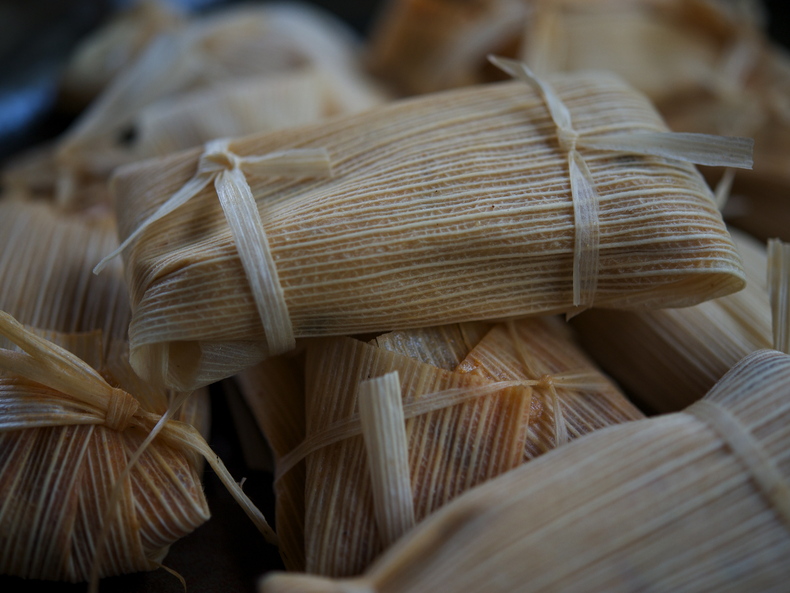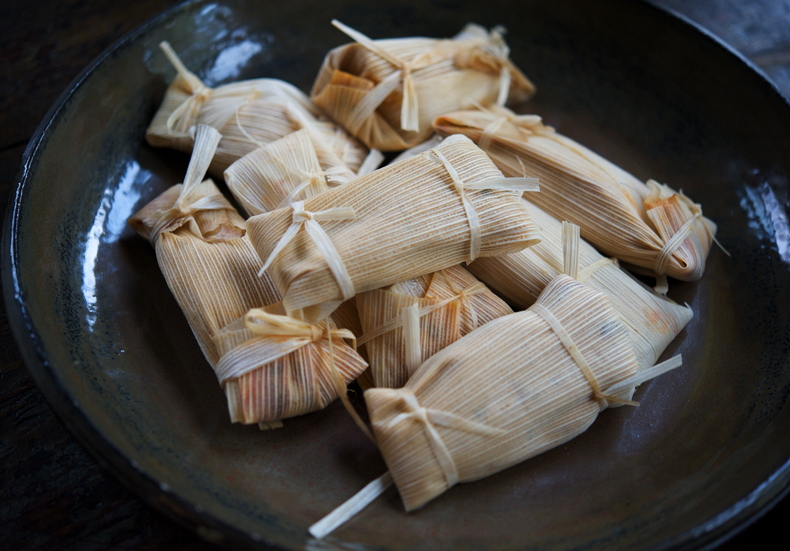4.6.10 Chile Today?


Red Chile Pork Tamales
- — 2/3 cup fresh pork lard, chilled (or vegetable shortening)
- — 1 teaspoon baking powder
- — 1 scant teaspoon salt
- — 1 3/4 cups masa harina mixed with 1 cup plus 2 tablespoons hot water and cooled to room temp
- — 2/3 cup chicken stock, ideally homemade
- — 8 ozs dried corn husks
- — 2 lbs boneless pork shoulder (aka Boston butt)
- — 1 tablespoon grapeseed oil
- — 1 small onion, finely chopped
- — 1 teaspoon Mexican oregano
- — 1 teaspoon cumin seeds
- — 1 teaspoon sea salt
- — 1 orange, sliced
- — 1 lime, sliced
- — 8 large dried New Mexico chiles, stems and seeds removed
- — 2 cloves garlic, peeled and finely chopped
- — 1/4 teaspoon freshly ground black pepper
- — 1/8 teaspoon ground cumin
- — 1 teaspoon sea salt
For the Masa:
In the bowl of an electric mixer fitted with the paddle attachment, combine the lard, baking powder and salt. Beat until light and fluffy. Add 1 cup masa and 1/3 cup stock; beat until thoroughly combined. Add the remaining masa and 1/3 cup stock; beat until light and fluffy, about 2 minutes. The batter should be soft but hold its shape in a spoon. Refrigerate at least 1 hour. Batter may be stored in an airtight container in the fridge for up to 2 days.
For the Red Chile Pork:
Heat oil in a Dutch oven over high heat and brown pork on all sides. Add remaining ingredients and cover with 4 cups water. Bring to a boil and then immediately turn heat down and simmer, covered, until tender, about 2 hours.
Preheat oven to 400 degrees. Remove pork from liquid and, when cool enough to handle, chop into ½” cubes. Spread in a single layer on baking sheet(s) and roast in the oven until nicely browned and crispy, about 20-30 minutes, stirring once or twice. Meanwhile, strain liquid and set aside, discarding solids.
For the Tamales:
To reconstitute the dried corn husks, place them in a deep heat-proof bowl and cover them with boiling water. Set a small plate on top of husks to keep them submerged. Soak for 1 hour, rearranging/agitating husks once to make sure all parts are soaked. Remove from water and spread on a clean kitchen towel.
Return the tamal batter to the mixer. On low to medium speed, mix the batter for a few seconds to lighten the dough. Add 3 tablespoons red chile sauce and mix again to combine. The batter should not be stiff, but slightly loose and not runny. You may need to add a few tablespoons or so of chicken stock. Remember, the lighter the batter, the more tender the tamales.
To assemble, tear (or cut with scissors) one large corn husk lengthwise along the grain to make 1/4-inch-wide strips. You will need two per tamale; if strips aren't long enough, you can tie two together. (Mother’s little helper comes in handy here.)
Place another whole husk, lightly dried, on work surface, pointed end away from you. Scoop about ¼ cup masa onto the middle and spread into a 4-inch square, leaving a 1 ½” border on the pointed end and a 1” border on the other sides. Spoon 2 tablespoons filling down the center of the masa. Bring long sides together to form a cylinder, making sure the batter encases filling. Fold the pointed end under; tie loosely with husk strip. Fold the flat end under; tie. Repeat. I know, I’m making it sound easy, and you will probably find the masa sticking and the corn husk tearing, etc. But these are incredibly forgiving and it’s really not about perfection here. Take your time and you’ll get the hang of it! Make these until you run out of masa. You may have leftover pork. This is a good thing.
To steam the tamales, I use one of those flat, collapsible metal steamers set inside a big pot. Put a few inches of water in the pot and line the steamer with leftover corn husks. Then pile in all the tamales (they can be stacked on top of each other), cover and set the steamer over high heat. When steam puffs out, reduce the heat to medium. Steam 1 hour 15 minutes, adding more water when necessary. (Do not let the pot dry out—it’s a disaster!!) To check for doneness, unwrap a tamal. If it’s ready, the masa will come free from the husk quite easily and feel soft. If masa sticks to the husk, rewrap, and comtinue steaming another 15-20 minutes. Remove from heat; let stand 15 minutes for batter to firm up. Tamales will remain warm for about 1 hour. Once cooled, these can be frozen and will keep for several months. To heat, place directly from freezer into steamer.
 Download Recipe
Download Recipe






4 Comments